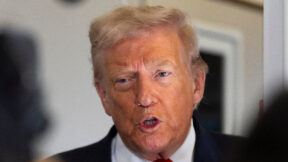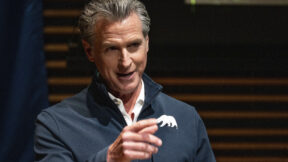Scandalous Allegations in a New York Times Report Pit Two Big Apple Institutions Against Each Other

AP Photo/Mark Lennihan
An investigative report published by the New York Times on another Big Apple institution, New York University Langone Health – the best hospital in the state and third-ranked hospital in the country per U.S. News and World Report – has pitted the two behemoths against each other. A close look at each of their cases provides a peek behind the curtain of how the sausage of investigative journalism comes to be made.
Last year, the Times purported to have uncovered a major scandal: At NYU Langone’s Manhattan location, it alleged, the Emergency Department prioritizes the rich, famous, and well-connected – so-called VIPs – by allowing them to jump in front of other patients and ensuring that they have access to private rooms, among other assorted benefits.
Friends and representatives of NYU Langone, including its namesake, Ken Langone, submit that what the Times report has discovered is nothing more nefarious than a friends and family program available to all staff as well as donors, from custodians to administrators. The story it produced, they say, is based on faulty information, and the real scandal is the careless journalistic practices the paper of record demonstrated in producing it.
At the crux of the hospital’s counter case against the newspaper is its contention that the story is based on the word of unreliable narrators and impeached sources.
According to Jim McCarthy, a longtime public relations advisor to Langone, the Times originally came to both the benefactor and beneficiary with an array of outrageous accusations about Ken Langone receiving preferential treatment at the hospital.
The Times asserted that it had been told by medical workers “accustomed to dealing with Mr. Langone’s minor ailments” that in one instance, Langone had arrived at the hospital in his private helicopter, where he cut the line and was treated for “stomach pain.” Both Langone and the hospital dispute that he has ever cut a line or arrived at the hospital by helicopter, and his medical records indicate that he arrived not just with discomfort, but an already-diagnosed bowel obstruction requiring surgical intervention.
Given the reasonable doubt it had over the allegation, the Times declined to publish anything on the incident, instead including another anecdote relayed to them by the same group of sources (according to correspondence between the Times and NYU obtained by Mediaite) in which other patients had been moved and a private room had been cleared for Langone’s arrival and the treatment of a two centimeter cut on his thumb.
Omitted from that account is the fact that Langone was on a blood thinner at the time, which, when combined with the billionaire’s own contention that he “couldn’t stop the bleeding” at his home, compelled him to show up at the ER. But two Times employees familiar with the story’s reporting process told Mediaite that they believed the paper’s reporting on the incident accurately reflected the seriousness of Langone’s condition. Medical records – provided to Mediaite with the patient’s permission – note that he presented to the hospital with “minimal oozing dark blood.”
The Times also keyed in on a 2021 incident in which Langone was afflicted with “stomach pain” and alleged the hospital held a room open for him before quickly treating and sending him home. NYU and Langone said that the Times again downplayed the risk to Langone’s health after having been initially misled by its sources.
The paper had originally presented NYU with allegations that the cause of Langone’s visit was “constipation,” as well as that his room’s curtains had been “steamed” ahead of his arrival. NYU denied these allegations.
In an interview with Mediaite, Langone himself explicitly denied that constipation could be counted among his symptoms. “I didn’t have constipation at all, that’s completely wrong,” he said. Langone’s medical charts do not indicate that he arrived at the hospital not with constipation, and he was diagnosed with an “intestinal infection due to enterotoxigenic E. coli”, which typically resolves itself, but presents special risks in elderly patients.
McCarthy believes that the Times account relied on “sources that have invented core details out of whole cloth,” and argued that the Langone anecdotes should have been discarded entirely, rather than framed in an accusatory light.
Those sources’ potentially illegal divulgence of Langone’s medical information, said McCarthy, impeaches them on ethical grounds as well.
But the journalists who spoke to Mediaite on the condition of anonymity expressed complete confidence in the accuracy of the reporting.
“We had a pretty unusual situation, which was that we had basically near unanimity in terms of the sources we’re talking to about the existence of this VIP program and the basic contours of how it worked,” one said. The sheer number of sources, in addition to their broad agreement, gave them “a lot of confidence” in the story.
Not only do they dispute that their sources were impeached, they argued the restraint the paper showed in not publishing details that were not absolutely verifiable was a testament to its integrity, not proof of its lacking.
The controversy over the story stretches beyond the care Langone has received. According to the hospital, the newspaper is without a single solid example of its friends and family program disadvantaging another patient.
In the nearest example of such an occurrence in the story, it is reported — under the subheading “Delayed Resuscitations” — that a private hospital room usually reserved for emergencies was occupied by a “VIP,” thus delaying another patient’s resuscitation, which was eventually performed successfully. Despite implied wrongdoing, the reporters do not present evidence suggesting the VIP enjoyed preferential treatment that resulted in his being provided the room.
Other anecdotes are told in a similarly indicting fashion, and according to NYU Langone, the Times presented its allegations to the hospital without details – including names and dates – that would allow it to fact-check them.
The Times objected to that characterization. “We provided them [NYU] with every single fact and detail that was in the story,” explained one of its employees. “It’s true that some of the details we had were not as precise as either they or we would have liked but… that’s how the cookie crumbles.”
NYU Langone is guilty of not only systemically discriminating to the benefit of the rich, but also to the detriment of the poor, according to the report, which accused the Emergency Department of sending a significant number of low-income or homeless patients to nearby Bellevue Hospital (which is also staffed in part by doctors affiliated with NYU). It also charged NYU with providing those admitted with only “cursory care.”
Hospital representatives were dumbfounded by this accusation, which is based on the word of NYC EMTs and Bellevue nurses. “NYU gave more than $56 million last year alone in treating what are known as ‘charity’ patients,” noted McCarthy, who also pointed out that between NYU Langone’s two locations (its other one is in Brooklyn) it served the third-most Medicaid patients in the city in 2019.
Dr. Fritz François, the chief of hospital operations at NYU Langone, denied the allegations wholeheartedly, describing the “practice of moving unwanted patients” as “not just unethical” but “unlawful.”
His counterpart at Bellevue, also an NYU employee, said that he has “encountered instances when other hospitals in NYC have inappropriately transferred undomiciled patients to Bellevue,” but “never” from NYU.
The divides between the Times and NYU Langone on how to handle a wide range of thorny issues pertaining to evidentiary standards, source credibility, and how much voice to give to a subject’s countervailing perspective provide a look into the wide range of judgment calls that need to be made before anything of this scale goes to print.
For those who worked on the story, the conversations with 45 medical professionals who confirmed its basic premise gave them more than enough confidence to not only run the piece, but feel they were providing a public service in doing so. “The narrative was so strong from the beginning about this VIP system. Like it’s not a question at all that VIP’s are prioritized over other patients… the story is correct,” one Times journalist told Mediaite.
The story undoubtedly reflects that sincerely held belief, but its subjects say that it had a corrosive effect on the reporting, compelling the Times to ignore contrary information, use questionable sources, and frame everything so as to villainize the institution.
McCarthy said that the piece was characterized by “staggering intellectual dishonesty and pretzeled contortions” that stood “in stark contrast to the demonstrable facts.” Langone, who has given hundreds of millions of dollars to NYU and helped make its medical school tuition-free, said that the medical center has never favored a well-connected patient “at the expense or the risk of any other patient.”
“It was a hit article,” he said.
In an official statement, the Times said that “all of the facts in the article were confirmed by multiple sources, and as the story noted, many of them were independently verified by an outside oversight group.”
“We unreservedly stand behind the article and the reporting process.”




